High-Frequency Treatments
In the late nineteenth century, a number of experimenters – including Paul Marie Oudin [1851-1923], Jacques-Arsène d’Arsonval [1851-1940] and Nicolas Tesla [1856-1943] – looked at the medical uses of high-frequency currents. One development from this research was the Vacuum Electrode – commonly known as the ‘Violet Ray’ – first developed by Frederick Finch Strong in 1896.
If the general employment of a new device by members of the medical profession may be taken as evidence of its practical value, the Vacuum Electrode may be justly regarded as the most important contribution to Electro-therapeutic Technic since the advent of the High-frequency Current. …
The use of hollow glass electrodes exhausted to a so-called “Low Vacuum” for the administration of High-frequency Currents originated through certain clinical experiments conducted by the writer in the laboratory of Dr. J . P. Sutherland, who is at the present time Dean of the Boston University School of Medicine.(Strong, 1908, p. 175)
The first glass electrode constructed by Frederick Finch Strong was made from a modified Geissler tube which had its “upper terminal covered by sealing wax and its opposite end fixed in an insulating handle” (Strong, 1908, p. 176). After this first model, Strong went on to make a range of tubes of different sizes and shapes that could be used with the Strong-Ovington Static Induction and High-Frequency Apparatus he developed with Earle Lewis Ovington. In 1903, the machine and the electrodes were put into commercial production by the Electro-Radiation Company of Boston and, by 1906, a battery-operated model was also on the market.
By the 1920s, a wide variety of glass electrodes – made from soda lime or borosilicate glass – had been developed for almost any part of the body, and high-frequency machines using these electrodes could be found in medical and dental clinics as well as some beauty salons. After the First World War, models became widely available for use in the home.
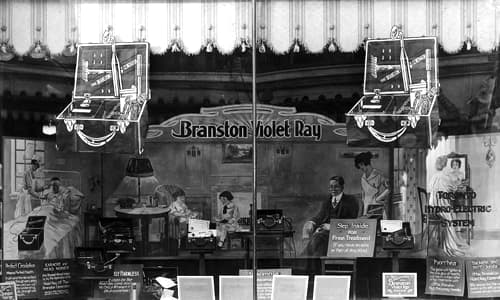
Above: 1918 Shop window display for the Branston Violet Ray.
These promised to alleviate a wide variety of aliments and the machines had good sales even during the depression years of the 1930s.
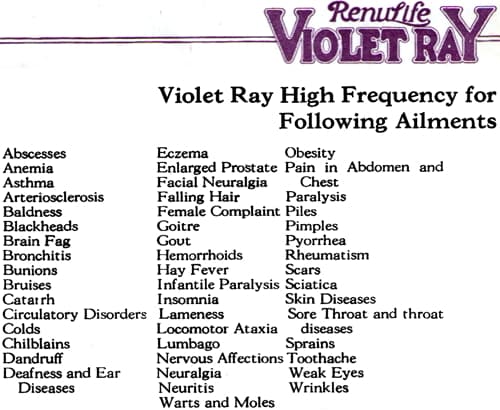
Above: 1919 Ailments treated by the Renulife Violet Ray.
By the 1940s, the medical and domestic use of violet ray devices was on the wane. In the United States, government prosecutions of violet ray manufacturers for false and misleading claims were physically removing many from the market. However, although their use in medicine, dentistry and in the home largely ceased, they continued to be used in many beauty salons. After a long absence, new forms of these devices have also reappeared for use in home beauty treatments.
Benefits
The primary benefit of these high-frequency treatments was believed to be their effect on circulation, the increased blood flow bringing more nutrients to the skin while helping to eliminate wastes.
When vacuum tubes are applied locally there is soon produced redness and hyperemia, with all of the resultant benefits on nutrition.
In short, the fundamental value of high frequency currents is their beneficial effect on all nutritive processes. Incidental to this we have increased oxygenation of blood and tissues, increased leucocytosis (and phagocytosis); and increased elimination.(Eberhart, 1911, p. 66)

Above: 1929 High-frequency electrode being used to treat a double chin by firming the neck muscles in a Helene Pessl salon in Vienna.
See also: Helene Pessl
The fact that the sparks produced ozone would also prove to be useful in some treatments.
High-frequency machines
A typical high-frequency machine used in a beauty salon consist of a central unit which produces a high-frequency, alternating current with a high voltage but low amperage connected to a hand piece into which glass electrodes of various shapes can be inserted.
The glass electrodes came in a variety of shapes and configurations. In the past they were filled with mercury vapour, neon or argon gas but most were simply made with air in a partial vacuum, the strength of which would determine the colour of the light generated when the power was turned on.
The vacuum of these electrodes or tubes varies from a very low to a very high degree. The degree of vacuum may be estimated by the color which is emitted. One of low vacuum emits a reddish glow and is the one of choice where relief from pain is the object to be attained. One of medium vacuum emits a bluish tint and one of high vacuum has a whitish appearance.
(Grover, 1922, p. 135)
As indicated above, different colours were believed by some to have different healing effects, an idea carried over from prevailing notions regarding the therapeutic effects of differently coloured light.
The red or red-pink vacuum besides giving off more heat, is sedative and useful in painful conditions and in acute diseases and inflammation.
The medium, blue, or blue-white vacuum gives off some chemical rays, and is more appropriate in chronic conditions. It is often employed where the white vacuum would really be indicated, as this contains not only blue and violet, but also some ultra-violet rays. All chronic ailments, where the vitality is impaired, skin diseases, indolent ulcers, etc., call for the employment of the white or blue-white tube.(Eberhart, 1911, pp. 52, 55)
See also: Red Light, Blue Light
The range of glass electrodes for use with high-frequency medical machines numbered twenty or more, but only a few of these were found in models produced for use in beauty salons. These included:
Bulb electrode: Used for facial and body work.

Saturator electrode: Held by the client during indirect treatments.
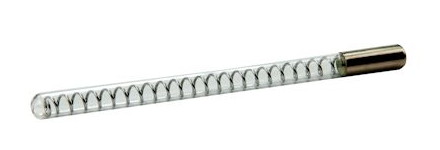
Fulguration electrode: Used to generate an intense concentrated spark to remove skin blemishes like moles and warts.

Neck electrode: Originally used medically for goiter treatments but could be used on any curved surface.
 >
>
Rake electrode: Used to treat alopecia and other hair problems.
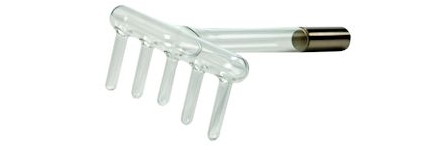
Salon treatments
All the high-frequency treatments carried out in beauty salons came directly from applications developed by the medical profession. Doctors applied high-frequency currents both generally and locally but only local treatments are currently used in beauty salons.
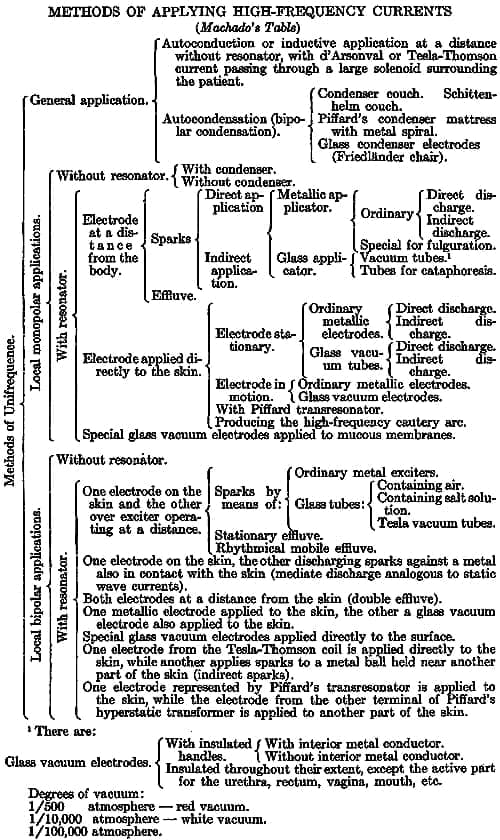
Above: 1915 A table of high-frequency treatment methods used in the medical profession. Only some of these treatments found their way into beauty salons.
The local high-frequency treatments commonly used in salons were done directly by applying an electrode directly to the skin or indirectly with the current flowing through the operator.
Direct Method
In this treatment the operator holds the glass electrode and applies it upwards and outwards over the client’s face. When in close contact with the skin, heat is generated at the point of contact with the electrode. However, if a small gap is included, sparking between the glass electrode and the skin ionises the air producing ozone was therefore used in the treatment of pimples but acne but other skin blemishes like psoriasis were treated in the past. On occasion, direct high frequency has also been used to disinfect the skin after hair has been permanently removed by electrolysis or thermolysis.
To help generate an even spark the electrode was often applied over gauze. This could be wrapped around the electrode but in most salons it was laid across the client’s face.
Indirect Method
In this procedure – also known as Viennese Massage – the client holds the saturator electrode while the operator massages the client’s face. The current flow between the client’s skin and the operator’s fingers heats the underlying tissue, an effect that could be increased if the area of contact between the operator and the client was reduced by using fewer fingers.
As with all heat treatments, the warmth was said to stimulate blood flow and therefore be good for the skin. The procedure was also regarded as relaxing but this could be counteracted if the use of electricity made the client nervous and tense. Similar effects could be achieved through a diathermy treatment or wrapping the face in a warm towel.
See also: Diathermy
Some treatments could be done either directly or indirectly.
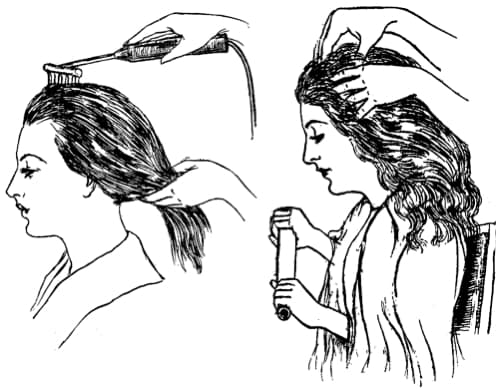
Above: Scalp treatment being done directly (left) or indirectly (right) (Wall, 1946)
Redundant salon treatments
Three other procedures commonly applied in the past are no longer in general salon use today.
General electrification
This general treatment had its basis in the idea that electricity is a ‘life-giving’ energy source. In the procedure the client was given the saturator electrode to hold and, after the current was turned on, was left to relaxed while her body was supposedly invigorated by being ‘charged with electrical energy’.
Fulguration
A fulguration electrode with a wire extruded from its end point produced a stream of electric sparks which could be directed to remove moles, warts and other skin blemishes. The medical profession also used fulguration to remove more serious problems such as skin cancers.
The orifice of the glass tube is placed on the growth and the current is turned on very gradually, thus causing local anathesia and making the operation practically painless.
The sparks must have a whitish appearance; if they become yellow and flame like, the result will be a burn, like with ordinary cautery and there will be an odor of burning flesh. That is not true fulguration.
A wart will first turn pink and then blanch. The time required varies with the size and may require more than one application especially if more than one blood vessel supplies nourishment, for all must be plugged or coagulated.
When moles are treated, a serum may exude after the first treatment and eventually the whole top may slough off.(Blood, 1932, p. 321)
An alternative method was to have the client hold the saturator electrode while the operator generated a spark indirectly using an all-metal electrode.
Fulguration was said to be as painless but this seems unlikely. Given the risk of pigmentation changes and scarring some beauty experts advised against it.
Even in the hands of an otherwise competent dermatologist, the use of the fulgeration point has often caused a hideous and hopeless pitting and scarring of the skin. It is, therefore, best left to those who have the mechanical skill as well as the correct knowledge of this operation.
(The science of beautistry, 1932, p. 209)
Understandably, most therapists today would consider the procedure far too risky to be conducted in a salon.
Cataphoresis
In the past, high-frequency machines were also used in conjunction with drugs like cocaine or chemicals like iodine. On occasion the impression was given that the current helped push these substances into the skin. As high frequency is an alternating not a direct current, this was not possible but the idea persisted despite numerous numerous statements to the contrary.
There is a so-called cataphoric glass electrode made and recommended by some for the ionization of drugs, but it is practically useless since a high-frequency current is an alternating one and has but little, if any, ionizing power. In order to drive medicaments into the skin a direct current is necessary.
(Grover, 1922, p. 136)
See also: Iontophoresis
Ozone
The spark from a high-frequency machine generates ozone and it was not long before glass electrodes were developed that could be used to inhale ozone directly into the nasal passages and lungs. Ozone inhalers were used medically to treat a variety of illnesses from colds through to asthma but the practice has fortunately been discontinued.
In Beauty Culture, high-frequency sparks were added to vapourising machines (steamers) to bathed the client’s face in a spray of steam and ozone. These can still be found in some salons today but many health authorities have banned their use. Although the amount of ozone produced by an ozone steamer is low, given that ozone is both an irritant and a poison it is probably best to avoid such treatments.
See also: Vaporisers (Steamers & Atomisers)
First Posted: 11th November 2013
Last Updated: 27th August 2021
Sources
Blood, I. H. (1927). The cosmetiste: A handbook on cosmetology with special reference to the employment of electricity in the care of the hair, scalp, and face at the direction and under the supervision of W. M. Meyer (4th ed.). Chicago, Ill: The W. M. Meyer Co.
Eberhart, N. M. (1911). A working manual of high frequency currents. Chicago: New Medicine Publishing Company.
Grover, B. B. (1922). Handbook of electrotherapy. Philadelphia: F. A. Davis Company.
Kassabian, M. K. (1910). Röntgen rays and electro-therapeutics. Philadelphia PA: J.B. Lippincott Company.
Monell, S. H. (1910). High frequency electrical currents in medicine and dentistry. Their nature and actions and simplified uses in external treatments. New York: William R. Jenkins Company.
The science of beautistry. Official textbook approved for use in all the national schools of cosmeticians affiliated with Marinello. (1932). New York: The National School of Cosmeticians, Inc.
Strong, F. F. (1908). High-frequency currents. New York: Redman Company.
Wall, F. E. (1946). The principles and practice of beauty culture (2nd ed.). New York: Keystone Publications.

Earle Lewis Ovington [1879-1936] (left) and Frederick Finch Strong [1872-1955] (right).
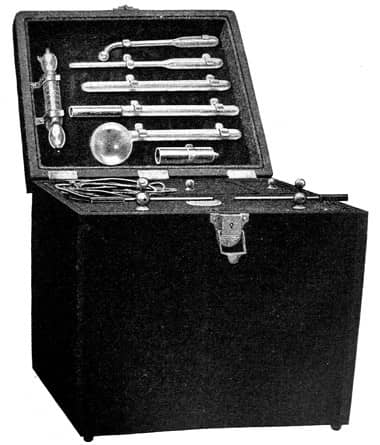
1906 The Junior Portable High Frequency Coil in a case of finished mahogany designed by Frederick Finch Strong . It was manufactured by the Electro-Radiation Company for medical use.

A range of high-frequency glass electrodes for use with the Rogers Vitalator. Every body surface and orifice is covered.
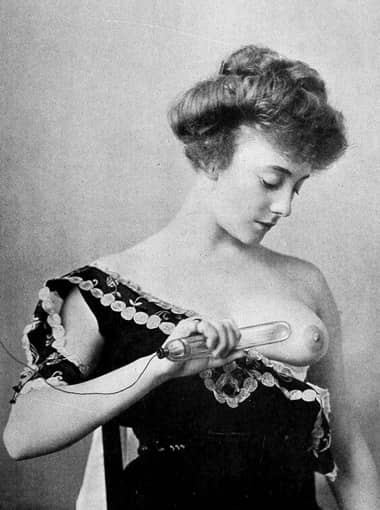
1910 Woman applying a high-frequency current to improve her flow of breast milk.
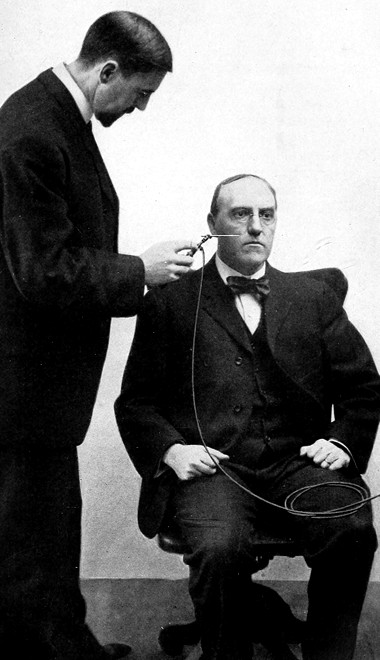
1910 Doctor treating an acne pustule by direct fulguration.
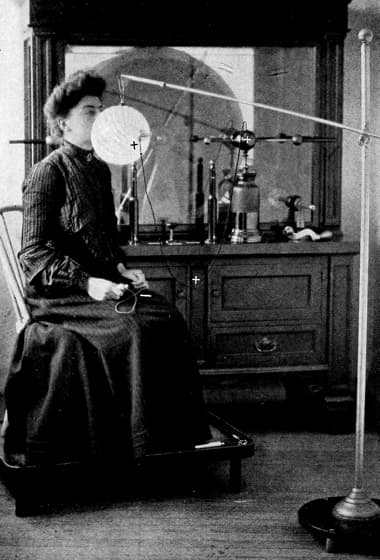
Medical Ozone Inhalation Treatment. “The oxygen of the air confined within the globe is broken up, forming ozone, by the convective discharge of the current passing from the numerous points of the brush within” (Kassabian, 1910, p. 109).
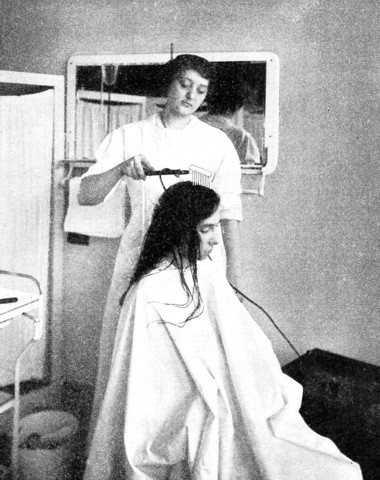
1914 Beauty treatment for the hair using the direct method and a rake electrode. Treatments were conducted for such things as dandruff, psoriasis and alopecia.
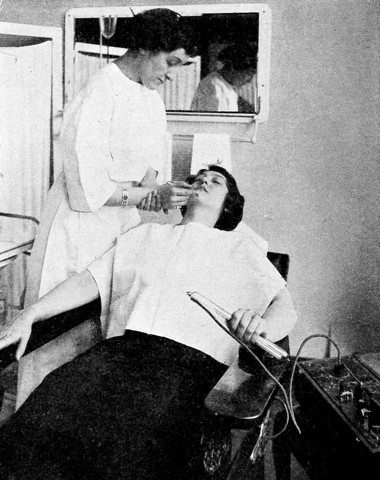
1914 Removing a mole with indirect fulguration using a metal electrode to generate a spark. The therapist is holding her working wrist to keep her hand steady.
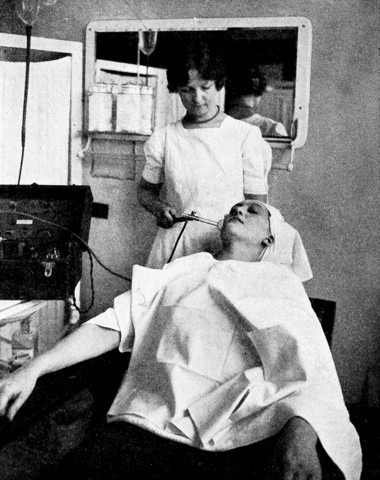
1914 Acne treatment using a bulb electrode.
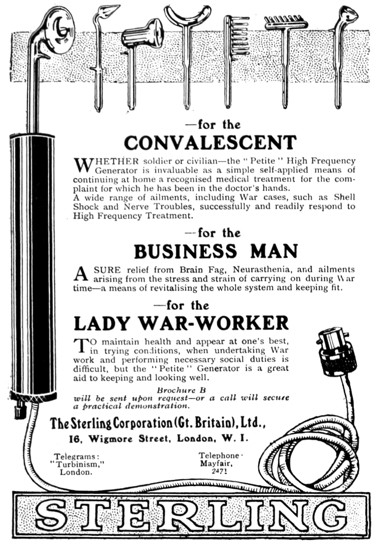
1917 Sterling High Frequency machine produced for general use.
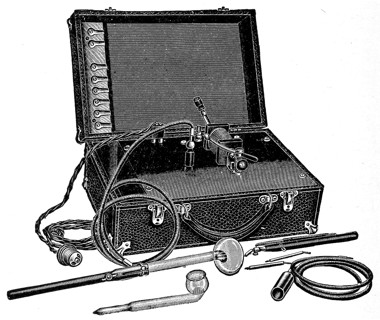
1918 McIntosh Violet Ray outfit. The machine was designed for use in a beauty salon.

1920 Violetta Violet Ray. Problems supposedly ‘cured’ by this machine include Asthma, Barber’s Itch, Boils, Blackheads, Catarrh, Chilblains, Colds, Constipation, Dandruff, Deafness, Earache, Eczema, Eye Disease, Falling Hair, Hay Fever, Headache, Goitre, Insomnia, Lumbago, Nervousness, Neuralgia, Neuritis, Pains, Paralysis, Pimples, Rheumatism, Skin Diseases, Sore Throat, Sprains, Tonsillitis, and Whooping Cough.

1937 High-frequency treatment which “drives the cream or oil on the skin right into the underlying tissue, with which you must deal if you wish to eradicate lines and wrinkles” suggests, incorrectly, that iontophoresis takes place during the treatment.
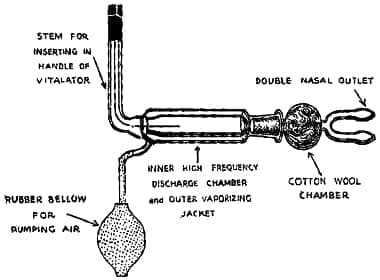
Ozone Inhaler used with the Rogers Vitalator.

c.1930 Inhaling ozone from a high-frequency machine.
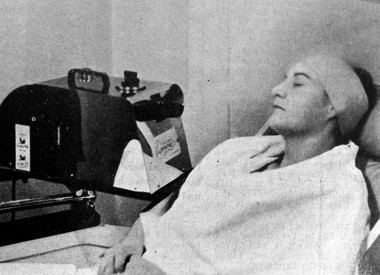
1936 An early ozone steamer. Modern ozone steamers use a mercury vapour tube to generate the ozone.
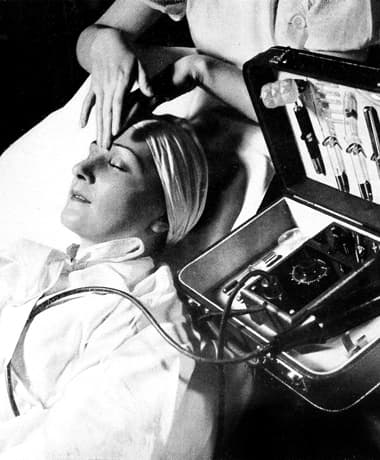
1936 Indirect high-frequency treatment, also known as Viennese massage.
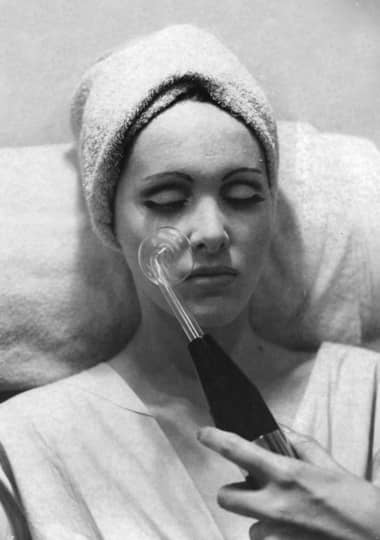
1967 Direct high-frequency facial treatment.
